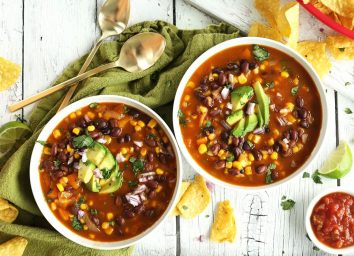7 Healthiest Chicken Broths & Stocks on Grocery Shelves—and 3 To Avoid
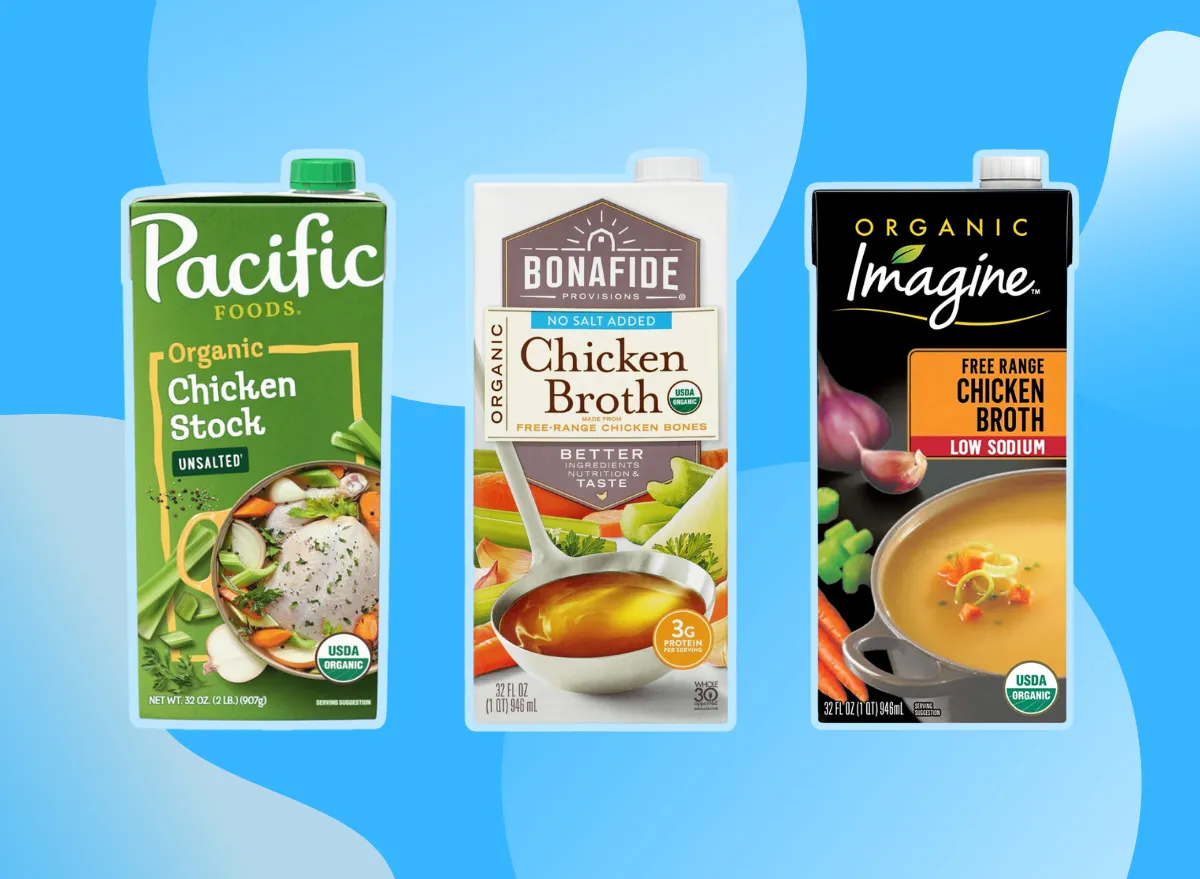
Chicken stocks and broths are a pantry staple for many home cooks. They're a great way to enrich grains, build your favorite soups, and spruce up sauces, gravies, and baked casseroles. Though you can make broth at home with a few simple ingredients, it's also convenient to keep a high-quality, store-bought carton on hand. It can be hard, however, to identify exactly which packaged options are worth buying and which are better left on shelves as many chicken stocks and broths contain unnecessary ingredients and loads of sodium. Luckily, we spoke to Eat This, Not That! medical review board member Lauren Manaker, MS, RDN to get her advice on which cartons are worth buying.
Before you head to the store, it's worth noting that there is a difference between chicken stock and broth, though the two terms are often used interchangeably.
To get technical, stock is made by simmering chicken bones with a mirepoix of onions, celery, and carrots; fresh herbs (typically parsley, bay leaves, and thyme); and black peppercorns. Stock is treated as a neutral ingredient that needs seasoning and further doctoring-up to be edible.
Broth, on the other hand, is a seasoned, flavorful liquid made from chicken meat, vegetables, and herbs that you can enjoy all on its own. Broth is what you ladle into your bowl with the chicken and noodles, while stock is the ingredient you added to the pot originally.
You'll also come across bone broths, which are high in protein and have a richer flavor and thicker body than traditional broths (they're also often pricier). That's because they're made by simmering bones for a longer cooking time which allows for the extraction of more nutrients and collagen protein.
The bottom line is that stocks are typically unsalted or very lightly salted while broths contain more sodium. If you're just looking to make mom's famous chicken noodle soup, though, you'll be set with a high-quality chicken stock made with a few simple ingredients.
How we chose the healthiest chicken stocks:
Chicken stock may sound like a simple, healthy food; however, to ensure you're picking up a dietitian-approved carton, we tapped registered dietitian and Eat This, Not That! medical review board member Lauren Manaker, MS, RDN for her shopping tips. Here's how we identified the healthiest chicken stocks:
- Low sodium: When it comes to the nutrition of stocks and broths, "usually, the largest concern is the sodium content," Manaker explains. "A healthier option ideally contains less than 500 milligrams of sodium per serving, so it doesn't significantly contribute to the daily sodium intake limit recommended by health organizations." The Dietary Guidelines for Americans recommends that adults consume less than 2,300 milligrams of sodium daily.
- Low calories and fat: Manaker also suggests opting for store-bought chicken broths with a lower fat content to avoid unnecessary added calories. Broths and stocks that pack more calories tend to be made with added ingredients like oil, chicken fat, or butter.
- Simple ingredients: Finally, check the ingredient list. "Choosing a broth or stock that is not made with fillers, oils, or anything artificial is ideal," says Manaker. She recommends avoiding "added sugars or sweeteners and artificial flavors," which can sometimes be disguised on an ingredient list as "natural flavors." After all, all you need to make great broth from scratch is fresh vegetables and herbs, chicken, and water. Your store-bought broth should follow a similar recipe.
7 Healthy Chicken Broths
Best: Bonafide Provisions Organic Chicken Broth – No Salt Added
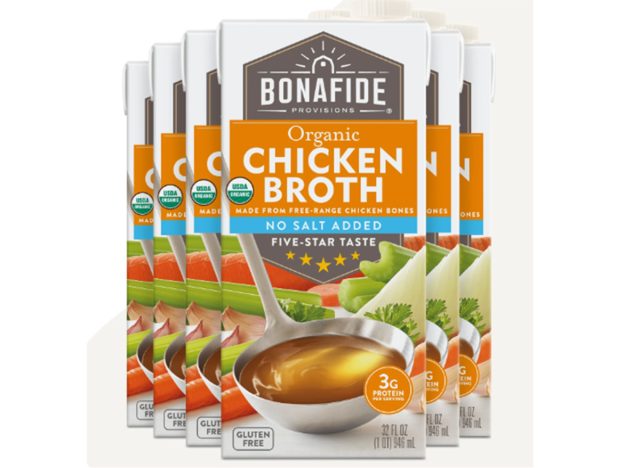
Calories: 15
Fat: 0 g (Saturated fat: 0 g)
Sodium: 55 mg
Carbs: 0 g (Fiber: 0 g, Sugar: 0 g)
Protein: 3 g
With just 55 milligrams of sodium per serving, this unsalted chicken broth gives you full control over the seasoning of your soups. It's also made with organic ingredients and gets a punch of acidity from apple cider vinegar to liven up the flavor.
Best: Aneto Low Sodium Chicken Broth
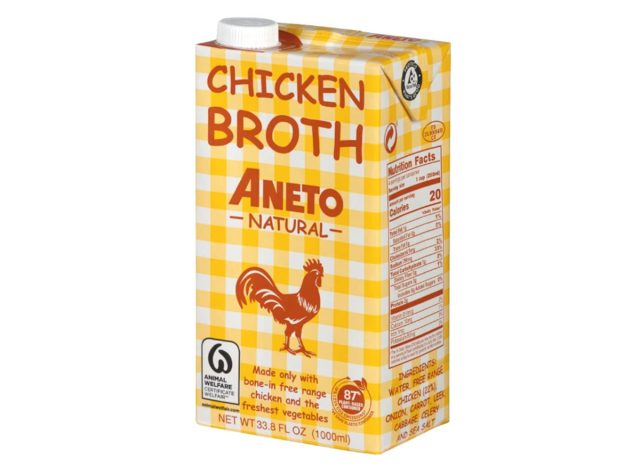
Calories: 16
Fat: 1 g (Saturated fat: 0 g)
Sodium: 300 mg
Carbs: 1 g (Fiber: 0 g, Sugar: 0 g)
Protein: 2 g
Aneto is a Spanish food company that produces paella bases and flavorful stocks for cooking. This simple low-sodium product is made with free-range chicken and fresh vegetables, including cabbage and leeks in addition to the more traditional mirepoix of onions, carrots, and celery.
Best: Imagine Free-Range Chicken Broth Low-Sodium
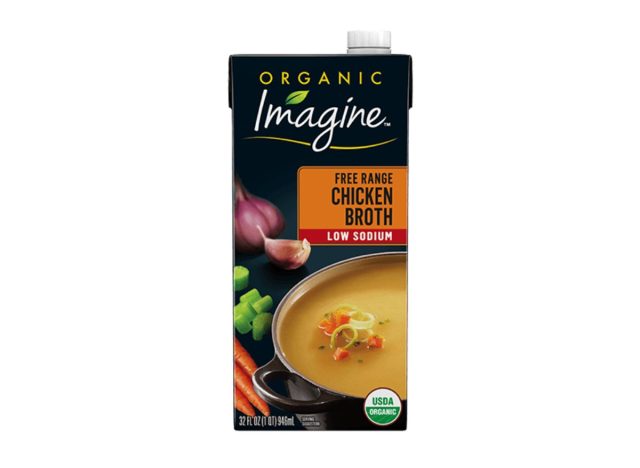
Calories: 5
Fat: 0 g (Saturated fat: 0 g)
Sodium: 115 mg
Carbs: 0 g (Fiber: 0 g, Sugar: 0 g)
Protein: 1 g
This broth is super light and subtle-tasting, with just 5 calories per serving. It's made with organic spices, vegetables, and chicken. The moderate 115 milligrams of sodium per serving ensures that this broth has some flavor without becoming a salt bomb.
Best: Fond Regenerative Chicken Bone Broth
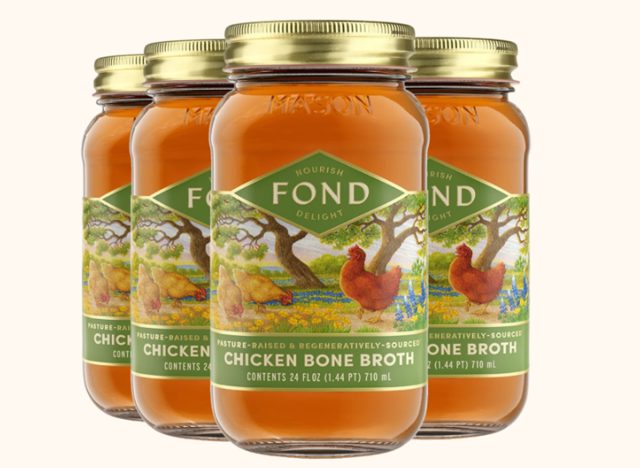
Calories: 25
Fat: 0.5 g (Saturated fat: 0 g)
Sodium: 260 mg
Carbs: 0 g (Fiber: 0 g, Sugar: 0 g)
Protein: 6 g
This jarred broth is made from three simple ingredients: water, chicken bones, and sea salt. It has a delicate flavor that infuses soups and sauces with meaty umami without overwhelming a dish with artificial flavorings. As a bonus, the broth is made only with pasture-raised regeneratively-sourced chickens.
Best: Kettle & Fire Reduced Sodium Chicken Bone Broth
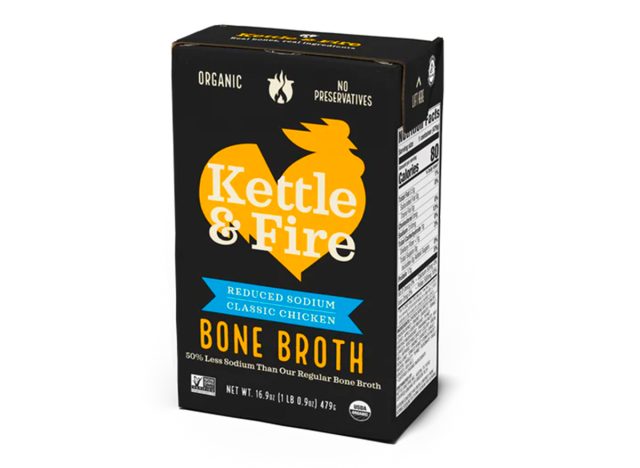
Calories: 80
Fat: 0 g (Saturated fat: 0 g)
Sodium: 250 mg
Carbs: 0 g (Fiber: <1 g, Sugar: 0 g)
Protein: 17 g
With a whopping 17 grams of protein per serving, this chicken broth has some staying power. It has a moderate amount of sodium that's still well below Manaker's threshold of 500 milligrams per serving and has a short and sweet ingredient list that includes organic chicken bones, vegetables, herbs, and apple cider vinegar.
Best: Pacific Foods Organic Unsalted Chicken Stock
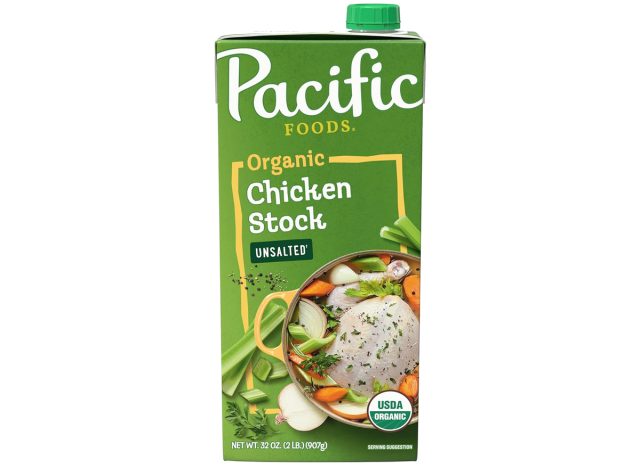
Calories: 30
Fat: 0 g (Saturated fat: 0 g)
Sodium: 100 mg
Carbs: 0 g (Fiber: 0 g, Sugar: <1 g)
Protein: 6 g
This stock is made with the good stuff: organic chicken, vegetables, and spices, without additives or extra salt. With 6 grams of protein and 100 milligrams of sodium per serving, this chicken stock falls right in line with Manaker's recommendations, plus it makes a neutral base for any soup.
Best: Bare Bones Low Sodium Chicken Bone Broth
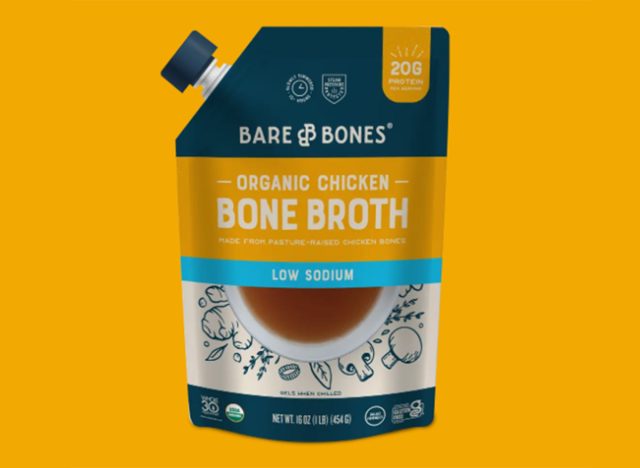
Calories: 15
Fat: 0 g (Saturated fat: 0 g)
Sodium: 55 mg
Carbs: 0 g (Fiber: 0 g, Sugar: 0 g)
Protein: 20 g
Bare Bones Low Sodium Bone Broth comes in a flexible and resealable plastic pouch. It's made with chicken feet, bones, and necks, which enrich the broth with collagen and give it more body and texture. This broth is also flavored with garlic, scallions, mushroom powder, tomato paste, and ginger juice, which add a rich and complex umami flavor good enough to sip on its own.
3 Chicken Broths to Avoid
Worst: Swanson Chicken Broth
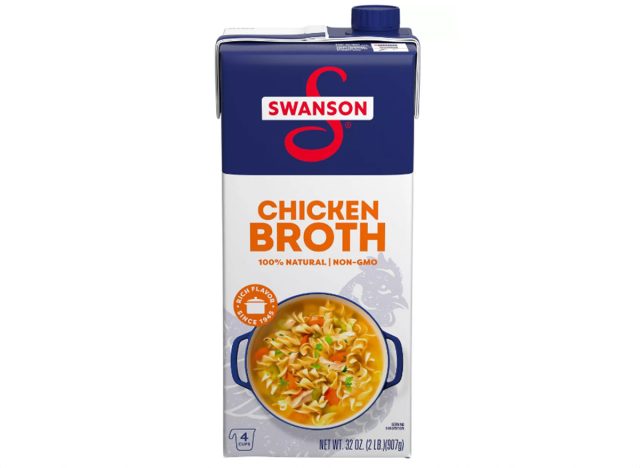
Calories: 10
Fat: 0 g (Saturated fat: 0 g)
Sodium: 860 mg
Carbs: 1 g (Fiber: 0 g, Sugar: 1 g)
Protein: 1 g
This chicken broth is enriched with added chicken fat and has a booming 860 milligrams of sodium per cup. In fact, the second ingredient is salt. It also contains yeast extract, which contributes additional sodium. This broth has a gram of sugar per serving, which isn't a ton in the grand scheme of things, but it's more sugar than most chicken broths contain and is easily avoidable with a healthier pick.
Worst: College Inn Chicken Broth
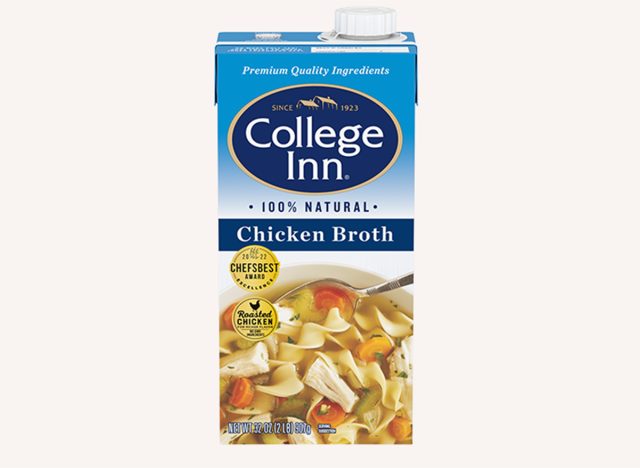
Calories: 5
Fat: 0 g (Saturated fat: 0 g)
Sodium: 850 mg
Carbs: 0 g (Fiber: 0 g, Sugar: 0 g)
Protein: 1 g
This well-recognized stock, which is sold in both a can and a carton, is heavily salted (each serving contains 850 milligrams of sodium). It has just 1 gram of protein and gets its taste from "natural flavors," which is an ambiguous term that doesn't necessarily include any real vegetables.
Worst: Kitchen Basics Organic Free-Range Chicken Stock
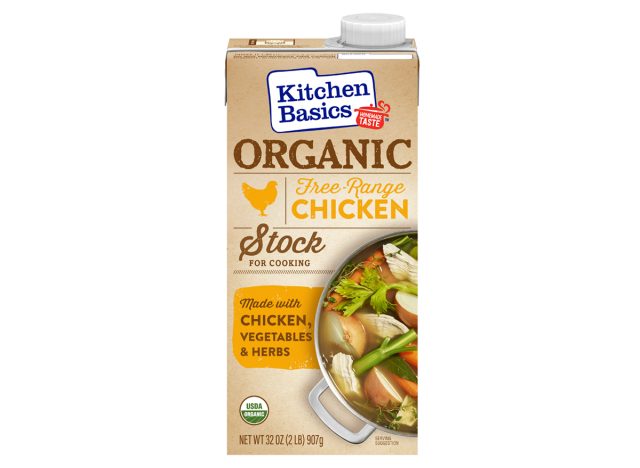
Calories: 20
Fat: 1 g (Saturated fat: 0 g)
Sodium: 400 mg
Carbs: 1 g (Fiber: 0 g, Sugar: <1 g)
Protein: 4 g
Though this broth is made with organic free-range chicken and the sodium content doesn't exceed Manaker's recommendations, the lengthy ingredient list makes this a product to avoid. This broth is made with "chicken flavor" and a blend of chicken and vegetable stocks, rather than the traditional method of simmering real chicken bones with real vegetables. It also contains potato flour, cane sugar, and molasses, all additives that are unnecessary in a high-quality stock for cooking or sipping.


